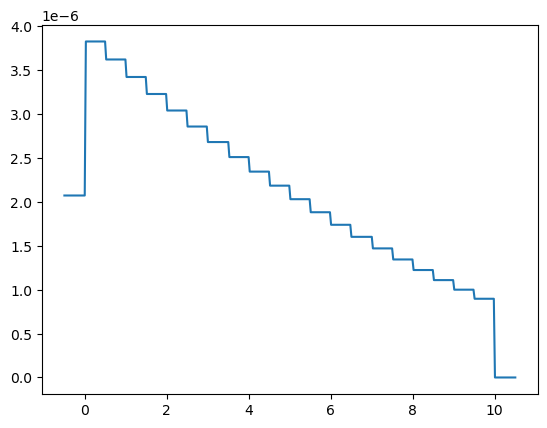1
2
3
4
5
6
7
8
9
10
11
12
13
14
15
16
17
18
19
20
21
22
23
24
25
26
27
28
29
30
31
32
33
34
35
36
37
38
39
40
41
42
43
44
45
46
47
48
49
|
#!/usr/bin/env python3
"""
Plot an SLD profile for a sample with a sliced particle layer.
"""
import bornagain as ba
from bornagain import angstrom, ba_plot as bp, deg, nm, sample_tools
import numpy as np
import matplotlib.pyplot as plt
def get_sample():
# materials
m_ambient = ba.MaterialBySLD("Ambient", 0, 0)
m_particle = ba.MaterialBySLD("Particle", 5e-6, 0)
m_substrate = ba.MaterialBySLD("SiSubstrate", 2.0704e-06, 0)
# layers
ambient_layer = ba.Layer(m_ambient)
substrate_layer = ba.Layer(m_substrate)
# particle layout
ff = ba.Cone(5*nm, 10*nm, 75*deg)
particle = ba.Particle(m_particle, ff)
layout = ba.ParticleLayout()
layout.addParticle(particle)
iff = ba.Interference2DLattice(ba.SquareLattice2D(10*nm, 0))
layout.setInterference(iff)
ambient_layer.addLayout(layout)
ambient_layer.setNumberOfSlices(20)
# sample
sample = ba.MultiLayer()
sample.addLayer(ambient_layer)
sample.addLayer(substrate_layer)
return sample
if __name__ == '__main__':
bp.parse_args()
sample = get_sample()
zpoints, slds = sample_tools.materialProfile(sample, 400)
plt.figure()
plt.plot(zpoints, np.real(slds))
bp.show_or_export()
|
 BornAgain
≻ 20
≻ Documentation ≻ Python scripting ≻ Plot and export ≻ SLD profile ≻ SLD profile with a sliced particle layer
BornAgain
≻ 20
≻ Documentation ≻ Python scripting ≻ Plot and export ≻ SLD profile ≻ SLD profile with a sliced particle layer
